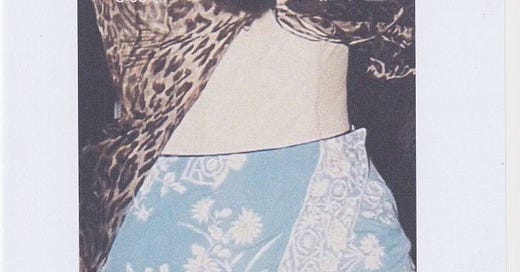—
I was a teenager in the late 90s. I welcomed in the millennium a month before I moved out of home. There was still a possibility for an alternate culture. Our ‘vibe’ was not prescribed by corporate consumer culture; we had to find our own dynamic look. Most of mine were found in The Love Shop on K Road, and the church store at the back of Lynn Mall. I made my first skirt in sewing class: an ill-fitted orange knee-length in traditional Chinese silk satin. I cut my tee shirts and used my mum’s old brooches to gather up the neckline. Being independent was important.
Non-conformist artist Margarita Tupitsyn wrote that, “it was about wearing things that reflected a personal attitude— a bit severe, conceptual, intelligent, critical— grouchy!” It makes me think of the recent wave of “uniform dressing”, the mainstreaming of style, and “minimalist wardrobes” that lack understanding for those days when you are just nothing but plain grumpy.
In terms of popular culture today, it seems that anything goes. Trends are too quick to realise, let alone enjoy, and brands have exposed too much of everything now that their essence has become amalgamated. A slur of products wind around my Instagram feed all day —an aggravating loop of promotion over preference.
My fashion stance has always been about mashing the new with the old. Isn’t this how we all love to dress, anyway? Building a life with clothes: the memories they store and the characters they enable. Wardrobes to be built overtime, pairing old favourites and injecting fresh shapes every so often to lift the experience of getting dressed. Clothing can frame a state of mind; put us in a certain mood, and, ultimately, activate our internal stance towards self-expression, allowing for our material choices to stand for our moral values.
It could be said that our wardrobes are albums, an archive of textiles compiled into patterns of sensations mapped by our impulses and reactions. Avid collectors who put sentimentality first will tell you to wear on the outside what you feel on the inside. Louise Bourgeois once said that “Clothing is an exercise in memory. It makes me explore the past: how did I feel when I wore that. They are like signposts in the search for the past.” I’ve been musing over this quote and would like to dedicate it to all those pieces in our wardrobes that we just can’t part with for this very reason. It seems ‘the collector’ in all of us is a sensitive creature and has a need for these garment’s tactile reminders: colour, texture, shape. So, we keep them, reminding us of ‘that time’ or ‘that place’ or more importantly, ‘that feeling’.
Why is it that we feel the need to hold onto clothing? Certain garments are designed to make us feel, walk and, essentially, live in a certain way, but when does it start to absorb our emotional state? Like a scent that is instantly transportable; freshly mowed grass, chlorine pools, secondhand bookstores, it is always that first hazy experience of wearing something that soaks in between its fibers and folded seams.
On the other hand, there are cloth-related items that we have no connection to. I knew a lady who when she turned 50-years-old announced a year of wearing one-colour outfits - strictly one colour for each month. She started by taking her current wardrobe to the local charity store, where she organised with the owner permission to swap-out her scheduled monthly colour with the next. And so she went, starting with the colour red - one of the easier colours to wear, she told me. “When I was feeling flat, red would instantly pick me up, give me energy, even make me feel sexy.” Yellow was her hardest feat. Even being liberal with the exact tone she was allowed to wear, often yellow would just get her down.
It makes me wonder, when we stand in front of our wardrobes, claiming there is nothing that feels right to put on, perhaps what we really mean is there is no piece of clothing that matches our emotional state. It would make sense then to take note of which pieces demanded or excluded different types of personalities, and to ask ourselves: do we want to use clothing to enable our morning mood, or do we want to use it as a tool to shift our psyche into feeling a certain way for the rest of the day? So, rather than being our signposts in the search for the past, as Louise Bourgeois suggests, perhaps garments can play a role in creating our signposts in the search of the future.
—
Extra notes:
This text is from two seperate pieces, the first: an essay I wrote many years ago for OK REAL, and the other is from some extracted text from an Editor’s letter for ISLAND magazine.






❤️❤️❤️ deepest love for this kind of thinking and conversation around clothes